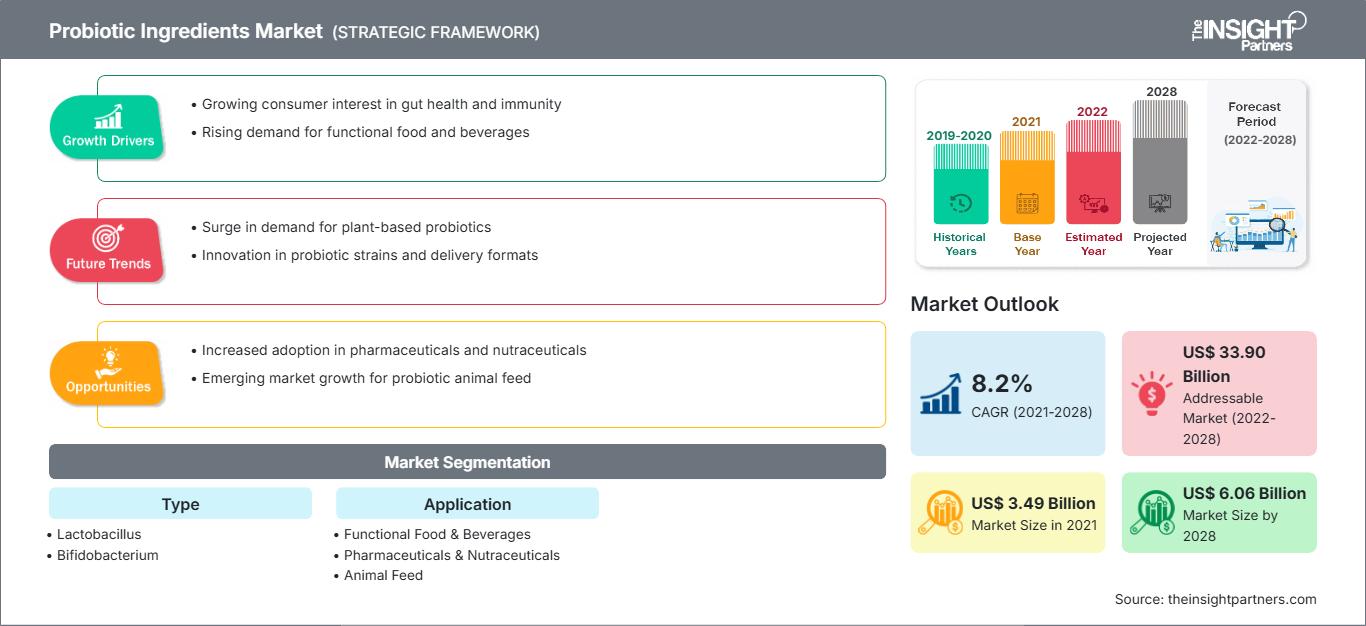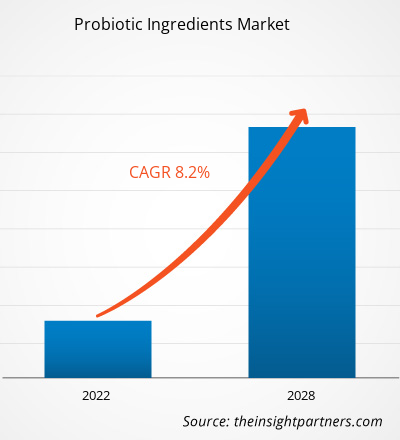Le marché des ingrédients probiotiques devrait passer de 3 493,42 millions de dollars américains en 2021 à 6 060,51 millions de dollars américains en 2028 ; il devrait croître à un TCAC de 8,2 % de 2022 à 2028.
Les probiotiques sont des micro-organismes vivants qui procurent des bienfaits pour la santé lorsqu'ils sont consommés, généralement en améliorant ou en restaurant la flore intestinale. Les probiotiques sont généralement considérés comme sûrs à consommer. Les probiotiques jouent un rôle important dans les soins de santé préventifs, car ils préviennent l'apparition de maladies en renforçant le système immunitaire. Ainsi, la sensibilisation croissante aux soins de santé préventifs devrait stimuler la croissance du marché au cours de la période de prévision.
L'Asie-Pacifique détenait la plus grande part de marché des ingrédients probiotiques en 2021, tandis que d'autres régions en développement, comme le Moyen-Orient et l'Afrique, devraient connaître une croissance significative au cours de la période de prévision. La croissance du marché est attribuée à la demande croissante d'aliments et de boissons fonctionnels, tels que les yaourts probiotiques à boire et les yaourts nature, ainsi qu'à l'influence croissante de la culture occidentale sur la jeune population de la région. De plus, les fabricants de probiotiques étendent leurs activités en Asie-Pacifique grâce à la présence d'une clientèle potentielle, d'une main-d'œuvre bon marché et d'installations de production adéquates. Des entreprises comme Probi et Bio-k+ (Kerry) sont actives dans la région ; cela devrait stimuler le marché des ingrédients probiotiques en Asie-Pacifique dans les années à venir.
Vous bénéficierez d’une personnalisation sur n’importe quel rapport - gratuitement - y compris des parties de ce rapport, ou une analyse au niveau du pays, un pack de données Excel, ainsi que de profiter d’offres exceptionnelles et de réductions pour les start-ups et les universités
Marché des ingrédients probiotiques: Perspectives stratégiques

-
Obtenez les principales tendances clés du marché de ce rapport.Cet échantillon GRATUIT comprendra une analyse de données, allant des tendances du marché aux estimations et prévisions.
Impact de la pandémie de COVID-19 sur le marché des ingrédients probiotiques
La pandémie de COVID-19 a posé des défis sans précédent à de nombreux secteurs début 2020. Les confinements, les restrictions aux frontières, les interdictions de voyager, l'arrêt de la fabrication et d'autres mesures de sécurité mises en place par les gouvernements conformément aux directives de l'OMS et des ministères nationaux de la Santé ont entravé les opérations de fabrication. Cependant, l'épidémie de COVID-19 a eu un impact positif sur le marché, car les consommateurs recherchent de plus en plus des alternatives naturelles et plus sûres pour rester en bonne santé et renforcer leur système immunitaire. La demande de compléments alimentaires a augmenté de façon spectaculaire au cours des premiers mois de la pandémie. De plus, comme les gens sont restés chez eux en raison des mesures gouvernementales, ils se sont concentrés sur leur santé et leur forme physique, ce qui a stimulé la demande de probiotiques pendant la pandémie.
Aperçu du marché : Demande croissante d’aliments et de boissons enrichis en probiotiques
Les consommateurs sont de plus en plus soucieux de leur santé et accordent plus d’attention à leur mode de vie et à leur alimentation, ce qui entraîne une explosion de la demande d’aliments et de boissons enrichis en probiotiques dans le monde entier. Pour répondre à la demande des consommateurs, les fabricants de produits alimentaires développent divers nouveaux produits avec des instructions et des images en réponse à la tendance actuelle en matière d’alimentation saine. Par exemple, Yakult Honsha, une entreprise japonaise, a lancé une boisson lactée probiotique en 1955, qui a été rejetée par plusieurs experts du secteur ; Cependant, il s'agit actuellement de la plus grande marque mondiale de produits laitiers probiotiques, présente en Asie-Pacifique, en Europe et en Amérique du Nord, ce qui stimule la croissance du marché.
Informations basées sur le type
En fonction du type, le marché des ingrédients probiotiques est segmenté en Lactobacillus, Bifidobacterium et autres. Le segment Lactobacillus devrait enregistrer la plus grande part au cours de la période de prévision. Il est considéré comme l'une des bactéries les plus sûres à utiliser comme probiotiques. Lactobacillus est un type de bactérie qui trouve principalement son application dans les aliments fermentés tels que le kéfir, la choucroute et le yaourt. Les souches de Lactobacillus sont utiles aux personnes car elles peuvent réduire les troubles intestinaux humains, ce qui devrait stimuler sa demande. La croissance du segment des lactobacilles est tirée par l'application croissante des probiotiques dans l'alimentation, en particulier les produits laitiers, ce qui alimente la croissance du marché.
Informations basées sur les applications
En fonction des applications, le marché des ingrédients probiotiques est segmenté en aliments et boissons fonctionnels, produits pharmaceutiques et nutraceutiques, aliments pour animaux, etc. Le segment des produits pharmaceutiques et nutraceutiques devrait enregistrer le TCAC le plus élevé du marché au cours de la période de prévision. La demande croissante de médicaments préventifs, le nombre croissant de troubles digestifs chez les personnes âgées et l'absence d'une alimentation équilibrée sont susceptibles d'accroître la demande de produits dans l'industrie des compléments alimentaires. Les consommateurs préfèrent de plus en plus les compléments alimentaires à base de probiotiques en raison de l'adoption croissante de régimes alimentaires malsains.
Les principaux acteurs du marché des ingrédients probiotiques sont ADM ; Novozymes A/S ; Chr. Hansen Holding A/S ; Kerry ; Lallemand Inc. ; IFF Nutrition & Biosciences ; AngelYeast Co., Ltd. ; Probiotical SpA ; Adisseo ; et Probi. Ces acteurs développent des produits à risques réduits pour la santé afin de répondre aux nouvelles tendances de consommation et de respecter les cadres réglementaires. Ils participent à des fusions et acquisitions, à des expansions d'activités et à des partenariats pour accroître leur part de marché.
Aperçu régional du marché des ingrédients probiotiques
Les tendances régionales et les facteurs influençant le marché des ingrédients probiotiques tout au long de la période de prévision ont été analysés en détail par les analystes de The Insight Partners. Cette section aborde également les segments et la géographie du marché des ingrédients probiotiques en Amérique du Nord, en Europe, en Asie-Pacifique, au Moyen-Orient et en Afrique, ainsi qu'en Amérique du Sud et en Amérique centrale.
Portée du rapport sur le marché des ingrédients probiotiques
| Attribut de rapport | Détails |
|---|---|
| Taille du marché en 2021 | US$ 3.49 Billion |
| Taille du marché par 2028 | US$ 6.06 Billion |
| TCAC mondial (2021 - 2028) | 8.2% |
| Données historiques | 2019-2020 |
| Période de prévision | 2022-2028 |
| Segments couverts |
By Type
|
| Régions et pays couverts |
Amérique du Nord
|
| Leaders du marché et profils d'entreprises clés |
|
Densité des acteurs du marché des ingrédients probiotiques : comprendre son impact sur la dynamique commerciale
Le marché des ingrédients probiotiques connaît une croissance rapide, portée par une demande croissante des utilisateurs finaux, due à des facteurs tels que l'évolution des préférences des consommateurs, les avancées technologiques et une meilleure connaissance des bienfaits du produit. Face à cette demande croissante, les entreprises élargissent leur offre, innovent pour répondre aux besoins des consommateurs et capitalisent sur les nouvelles tendances, ce qui alimente la croissance du marché.

- Obtenez le Marché des ingrédients probiotiques Aperçu des principaux acteurs clés
- Analyse historique (2 ans), année de base, prévision (7 ans) avec TCAC
- Analyse PEST et SWOT
- Taille du marché Valeur / Volume - Mondial, Régional, Pays
- Industrie et paysage concurrentiel
- Ensemble de données Excel
Rapports récents
Rapports connexes
Témoignages
Raison d'acheter
- Prise de décision éclairée
- Compréhension de la dynamique du marché
- Analyse concurrentielle
- Connaissances clients
- Prévisions de marché
- Atténuation des risques
- Planification stratégique
- Justification des investissements
- Identification des marchés émergents
- Amélioration des stratégies marketing
- Amélioration de l'efficacité opérationnelle
- Alignement sur les tendances réglementaires






















 Obtenez un échantillon gratuit pour - Marché des ingrédients probiotiques
Obtenez un échantillon gratuit pour - Marché des ingrédients probiotiques